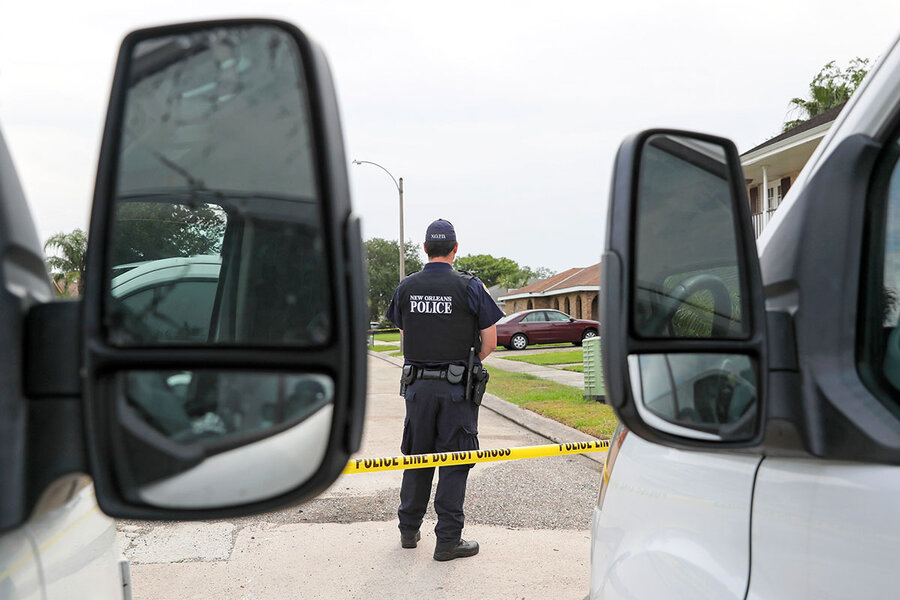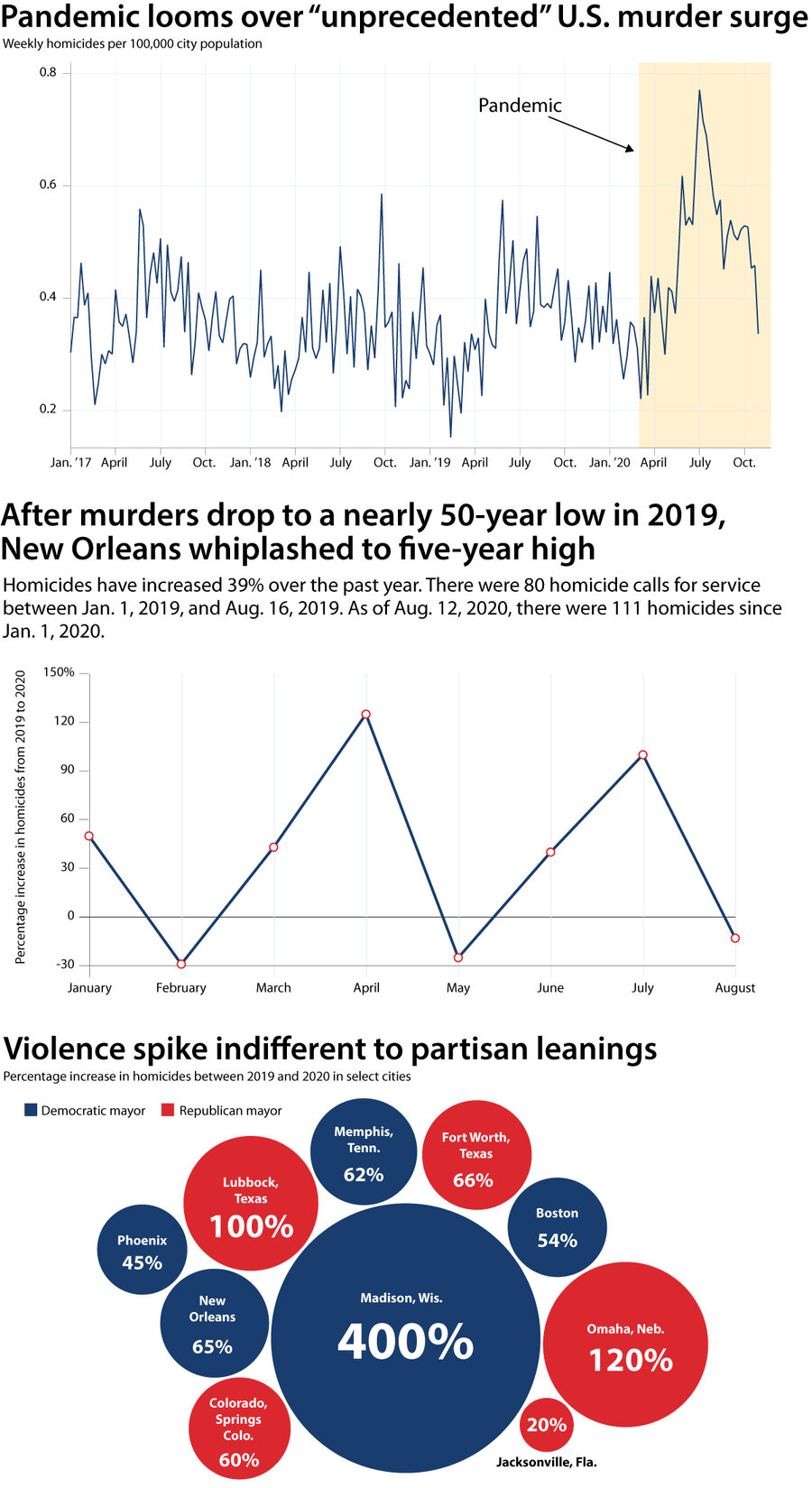2020’s murder increase is ‘unprecedented.’ But is it a blip?
Loading...
Overall crime has dropped dramatically in the United States since the late 1990s. But the 2020 homicide rate “now exceeds the rates of the late ’80s and ’90s, before the big drop,” says Richard Rosenfeld, lead author of “Pandemic, Social Unrest and Crime in US Cities,” a new report. “This round of crime increase is unprecedented.”
This year, 51 cities across the U.S. saw an average 35% jump in murder from 2019 to 2020 – a “historically awful” development, says New Orleans-based crime analyst Jeff Asher, who crunched those numbers. A different study looking at 21 U.S. cities found 610 more murders in those jurisdictions this year over last year. In those cities, gun assaults increased by 10% over 2019.
Why We Wrote This
The spike in murder across the board in the United States defies easy explanation. But getting control of the pandemic looms large on lists of proposed solutions.
Those who want to read partisanship into the trend will be disappointed. Like the pandemic, murder doesn’t discriminate by political affiliation.
“When society’s norms and values are in flux or have disappeared or disintegrated, people don’t know how to behave,” says Kim Davies, a sociologist who studies the dynamics of violent crime. “It’s a kind of normlessness that gives way to ‘Nothing matters.’ [The murder increase] is similar to spikes in suicide when we’ve had economic depressions. But nothing like this has ever happened.”
After police discovered Huong Nguyen’s body in a car trunk earlier this year in New Orleans East, suspicion fell on her brother.
After being spotted on a surveillance camera walking away from his sister’s car the night she disappeared, Hoa Nguyen has been charged and, if convicted, could spend the rest of his life in prison.
For all its singular tragedy, Ms. Nguyen’s death is part of a tide of gun violence rising from New Orleans to Lubbock, Texas. Coming off a record low in homicides in 2019, New Orleans saw its rate spike by over 50% this year. It is not, by any stretch, an outlier. Lubbock doubled its murder rate, so far, from 2019 to 2020.
Why We Wrote This
The spike in murder across the board in the United States defies easy explanation. But getting control of the pandemic looms large on lists of proposed solutions.
To be sure, overall crime has dropped dramatically in the U.S. since the late 1990s. But the 2020 homicide rate “now exceeds the rates of the late ’80s and ’90s, before the big drop,” says Richard Rosenfeld, lead author of “Pandemic, Social Unrest and Crime in US Cities,” a new report. “This round of crime increase is unprecedented.”
This year, 51 cities of various sizes across the U.S. saw an average 35% jump in murder from 2019 to 2020 – a “historically awful” development, says New Orleans-based crime analyst Jeff Asher, who crunched those numbers. A different study looking at 21 U.S. cities found 610 more murders in those jurisdictions this year over last year. In those cities, gun assaults increased by 10% over 2019.
Those who want to read partisanship into the trend will be disappointed. Like the pandemic, murder doesn’t discriminate by political affiliation: Cities with Democratic mayors are seeing the same increases in lethal violence as cities with Republican mayors.
“We’re seeing it pretty much across the board in places like New Orleans ... but also in smaller places like Omaha, Nebraska, that don’t typically have a lot of murders,” says Mr. Asher. “It’s really not something that’s got a lot of easy explanations.”
Calls for service and arrests in cities like New Orleans have plummeted in a pandemic year, though underreporting could be a factor in those drops.
One nonviolent crime that’s rising is shoplifting. An estimated 54 million Americans are struggling with hunger this year, a nearly 50% rise since 2019. High joblessness, the end of federal pandemic aid, and a relative lack of a safety net in the U.S. are leading to high rates of despair, experts say.
The pandemic’s grating effects and the electorate’s rebuke of a norm-busting presidency have dominated the national psyche. As Americans have bought guns at record rates, some research suggests a causal increase in those weapons being used against others.
The biggest spike in gun violence, notes Mr. Rosenfeld, came in the weeks of social unrest in late spring and summer after George Floyd was killed by police in Minneapolis.
What’s more, there is evidence that the bulk of the violence is occurring in poorer working class neighborhoods, such as New Orleans East, that have been hit hardest by the pandemic’s economic downturn and the backlash to calls for police reform.
Police activity – or lack of it – “is more likely a symptom of this concept of police legitimacy, where police pull back because people are upset and questioning their legitimacy,” says Mr. Asher in New Orleans. “And when people don’t believe that the police are going to be a natural arbiter, perhaps they’re more likely to take things into their hands – more retribution killings. But ... I’m skeptical that the explanation for why murder is going up everywhere is because police have somehow changed.”
After all, “murder is often mundane,” says Kim Davies, a researcher at Augusta University, usually involving people known to one another, often over insults or resentments fueled by alcohol and other drugs, the use of which have risen during the pandemic.
Interpersonal toxicity, she says, can be exacerbated by more foundational shifts – such as once in a century-level health crisis and a bitter election in which a peaceful transition has come under threat.
“When society’s norms and values are in flux or have disappeared or disintegrated, people don’t know how to behave,” says Ms. Davies, a sociologist who studies the dynamics of violent crime. “It’s a kind of normlessness that gives way to ‘Nothing matters.’ [The murder increase] is similar to spikes in suicide when we’ve had economic depressions. But nothing like this has ever happened.”
That unique dynamic also gives researchers hope that 2020 becomes a statistical anomaly.
“The strategy to reduce violence is, first and foremost, to subdue the pandemic,” says Mr. Rosenfeld, a professor emeritus and criminologist at the University of Missouri-St. Louis. “The second is to redouble smart policing activity. And the third is to take the essence of police reform seriously, because if police aren’t able to repair the relationship with communities in the cities that have experienced this uptick, I don’t think any crime reductions that might occur from more policing are going to last long.”










